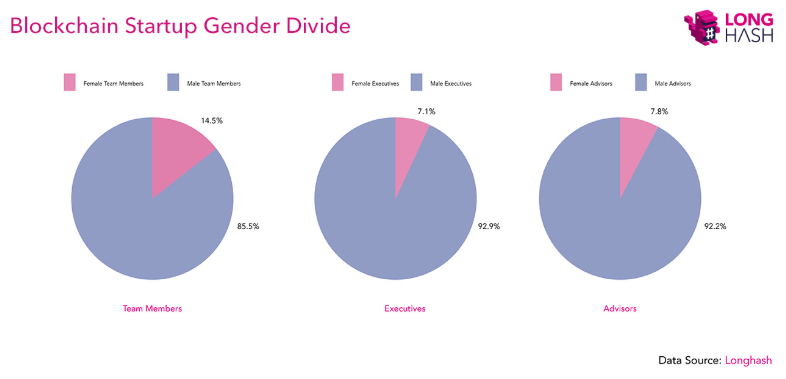Breaking news: There aren’t a lot of women in blockchain.
Surely you catch the sarcasm. The blockchain/cryptocurrency space is known for its high concentration of white men, kind of like the U.S. Congress or the membership of a New England country club (which, to be fair, likely overlap). The phrase “women in blockchain” comes up frequently—on disappointing cruise ship panels, in meetup groups, and in news stories about attempts to make blockchain more “inclusive”—because they’re seen as rare creatures worth studying, like the pygmy three-toed sloth. Even UNICEF’s Innovation Unit, an organization that strives for gender inclusivity and has a staff that’s 70 percent women, could only find one female founder in the six blockchain startups to which it recently promised funding.
A report out this week from LongHash, an organization that analyzes blockchain-related data, suggests just how bad the gender gap might be. Of the 100 most recently launched blockchain startups LongHash compiled from the website ICO Rating, 85 percent of the total 1,062 listed team members (which included 326 C-suite executives and 473 advisors) were men, according to information provided by the companies on their own websites. Men made up nearly 93 percent of executive positions, roughly the same percentage as male advisors. Thirty-seven of these new startups had no women on their teams whatsoever, while 78 had no female executives.

LongHash went deeper into these numbers and discovered they were generous. When it raised the bar to look for startups with more than one female executive, LongHash found only one. When it discounted two startups that had unusually large advisory boards, the percentage of female advisors fell below six. And it’s rare for companies to have both female advisors and female executives. Perhaps this indicates a “checking a box” attitude toward including women among a team’s higher-ups.
There were disclaimers for LongHash’s research. Some team members had gender-neutral names that may have muddied the data, and typically gendered names don’t always correspond to people’s gender identities. Then there’s the possibility that startups, being startups, didn’t quite have it together to include all of their team members on their websites—or they’re in the process of adding new people (maybe women!) to their growing companies.
Meanwhile, the companies listed on ICO Rating seem to vary widely in their legitimacy; its list of newest startups include an “infused water” blockchain company and something called Honey Badger Investment Fund, which is “dedicated to financing invoices globally with the use of blockchain technology” and wants to raise more than $100 million in its upcoming ICO. In other words, let’s take LongHash’s data with a grain of salt.
That said, there are plenty of other statistics that point to the gender disparity in blockchain. According to Google Analytics data analyzed by Coin Dance, a bitcoin statistics platform, bitcoin community engagement is dominated by men, who make up about 91 percent of this “engaged” group of the bitcoin-involved.
A May 2018 study from Quartz found that gender disparity in the crypto/blockchain space goes back at least to 2012. Quartz looked at 378 venture-backed companies founded between the start of that year and January 2018, discovering that just one had an entirely female founding team, while only about 8 percent of founding teams included women at all. Among blockchain companies, about 85 percent had all male founders, while close to 75 percent of founding teams at other types of tech companies in that time span were all male. Of the 1,004 people Quartz surveyed through its social media channels and newsletter (an inherently skewed sample), 81 percent who said they were somehow involved in cryptocurrency were men.
Blockchain companies, of course, aren’t alone in their lack of women; even established tech giants struggle to attract and retain female employees. At Facebook, for instance, 36% of global employees are female (bad, but decidedly better than blockchain companies). Let’s give big boy Mark Zuckerberg a grateful pat on the back.
All of this data may make you wonder, “What must it be like to be a woman in blockchain?”
You can probably imagine. Sexism and misogyny happen in largely male-occupied spaces…and in mostly female-occupied spaces, like New York City. However, highlighting the lack of women in an industry can also discourage other women from approaching it, further widening the gender gap.
Then there’s the inherent problem of someone’s minority status inappropriately defining them; people who are doing interesting work want to be recognized for that, not for what bathroom they use. So next time you get the urge to ask a woman what it’s like to be a woman in blockchain, think about that—and then don’t ask.